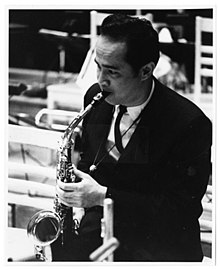Gabe Baltazar
Gabe Baltazar | |
|---|---|
 Gabe Baltazar, circa 1962 | |
| Background information | |
| Birth name | Gabriel Ruiz Hiroshi Baltazar Jr. |
| Also known as | Gabe Baltazar |
| Born | November 1, 1929 Hilo, Territory of Hawaii, U.S. |
| Origin | United States |
| Died | June 12, 2022 (aged 92) Hilo, Hawaii, U.S. |
| Genres | Jazz Pop |
| Occupation(s) | Musician, conductor, music director |
| Instrument(s) | Saxophones Clarinets Flutes Piano Oboe |
| Years active | 1948–2022 |
| Labels | Capitol Contemporary Creative World |
| Website | |
| Military service | |
| Allegiance | |
| Service/ | |
| Years of service | 1950–1954 |
| Unit | 356th Army Band (Fort Belvoir) |
Gabriel Ruiz Hiroshi Baltazar Jr. (November 1, 1929 – June 12, 2022) was an American
Background and early years
Gabriel Ruiz Hiroshi Baltazar Jr. was born in
Musical education, meeting with Charlie Parker, move to Los Angeles
Gabe Baltazar was first playing music at the age of eleven when he was started on the
In 1945, Baltazar was the first recipient of a musical scholarship fund at Punahou School of Music under the auspices of the Filipino Art Lovers' Club.
After his graduation from
Baltazar was drafted when the Korean War started and served in the United States armed forces from 1950 through 1954 at Fort Belvoir in Washington D.C. After that he moved back to Hawaii and played with the Royal Hawaiian Band for two years[5] later moving to Los Angeles playing and recording with Paul Togawa in the late 1950s. Baltazar first attended Los Angeles City College on the G.I. bill and then later transferred in 1958 to Los Angeles State College following in the footsteps of the alto saxist and Stan Kenton alum Lennie Niehaus.[3][2] He eventually completed a B.A. in Music in February 1967 at Los Angeles State College. While there he was initiated into the Phi Mu Alpha Sinfonia fraternity on December 1, 1957. Baltazar replaced Niehaus in 1960 with Kenton after he was heard on a concert by the bandleader during a Los Angeles State College concert; Baltazar was working for the Russ Morgan orchestra at the time.[5][2]
Los Angeles and the Stan Kenton Orchestra
Baltazar spent a brief unrecorded period in 1959–60 with the
After leaving the Kenton organization, Baltazar worked with
Return to Hawaii and later musical career
Baltazar returned home to Hawaii in 1969 to rejoin and then become assistant director of the
In 2012, the
Death
Gabe Baltazar died in Hilo on June 12, 2022, at the age of 92.[6]
Discography
As a Leader
- Stan Kenton presents Gabe Baltazar(Creative World, 1979)
- Gabe Baltazar Quartet: Back in Action (V.S.O.P., 1992)
- Gabe Baltazar: Birdology (Fresh Sound, 1992)
With Paul Togawa
- The Paul Togawa Quartet featuring Gabe Baltazar (Mode Records, 1957; V.S.O.P., 1987; CD issue: 1996)
With Stan Kenton
- Two Much! (Capitol, 1960) - with Ann Richards
- The Romantic Approach (Capitol, 1961)
- Kenton's West Side Story (Capitol, 1961)
- Sophisticated Approach (Capitol, 1961)
- Adventures in Standards (Creative World, 1961 [rel. 1975])
- Adventures In Jazz(Capitol, 1961)
- Adventures in Blues (Capitol, 1961 [rel. 1963])
- Adventures in Time (Capitol, 1962)
- Artistry in Bossa Nova (Capitol, 1963)
- Stan Kenton / Jean Turner (Capitol, 1963) - with Jean Turner
- Kenton / Wagner (Capitol, 1964)
With Gil Fuller
- Gil Fuller & the Monterey Jazz Festival Orchestra featuring Dizzy Gillespie (Pacific Jazz, 1965)
- Night Flight with Gil Fuller and James Moody (Pacific Jazz, 1965)
With Onzy Matthews
- Onzy Matthews: Mosaic Select (Originally recorded for Capitol 1963–1965. Mosaic, 2007) 3-CD set
With Oliver Nelson
- Sound Pieces (Impulse, 1966)
- Live from Los Angeles: Oliver Nelson's Big Band (Impulse, 1967)
With Richard Simon
- Groove Therapy (UFO Bass, 1995)
With Noel Okimoto
- Ohana: Featuring Makoto Ozone and Tiger Okoshi (Roy Sakuma Productions, 2003)
See also
Notes
- ^ Scott Yanow (November 1, 1929). "Gabe Baltazar | Biography & History". AllMusic. Retrieved March 2, 2020.
- ^ a b c d e f g Baltazar, Gabe. Garneau, Theo. "If It Swings, It's Music The Autobiography of Hawai'i's Gabe Baltazar Jr". University of Hawaii Press. 2012.
- ^ a b c d Harris, Stephen. The Kenton Kronicles, Dynaflow Publications. Pasadena CA. 2000. pp. 199-202
- ^ YouTube
- ^ YouTube
- ^ Jazz legend Gabe Baltazar Jr. passes away
Sources
- Danny Barcelona RIP, Gabe Baltazar, Contemporary of Danny Barcelona, JazzReview.com, Saturday, April 7, 2007, retrieved on: July 6, 2007.
- "Hawaii News | Honolulu Star-Advertiser". Starbulletin.com. February 25, 2020. Retrieved March 2, 2020.
- "honolulujazzscene Resources and Information". Honolulujazzscene.net. Retrieved March 2, 2020.
- "Gabe Baltazar, Jr. | The Hawaii Book and Music Festival". Hbmf.wordpress.com. April 14, 2012. Retrieved March 2, 2020.
- "STAGE PRESENCE edited by Theodore S. Gonzalves :: book review". Home.nestor.minsk.by. October 26, 2010. Retrieved March 2, 2020.
External links
- Gabe Baltazar discography at Discogs
